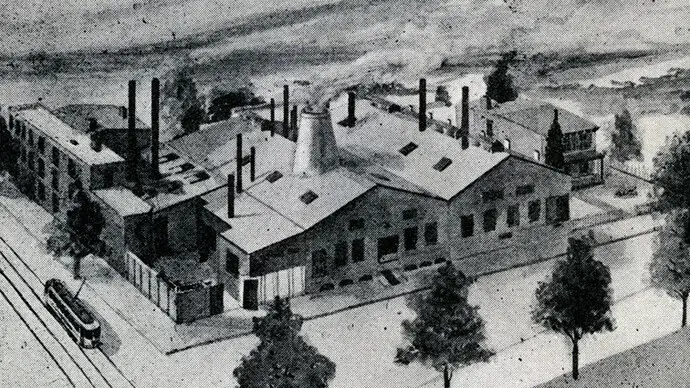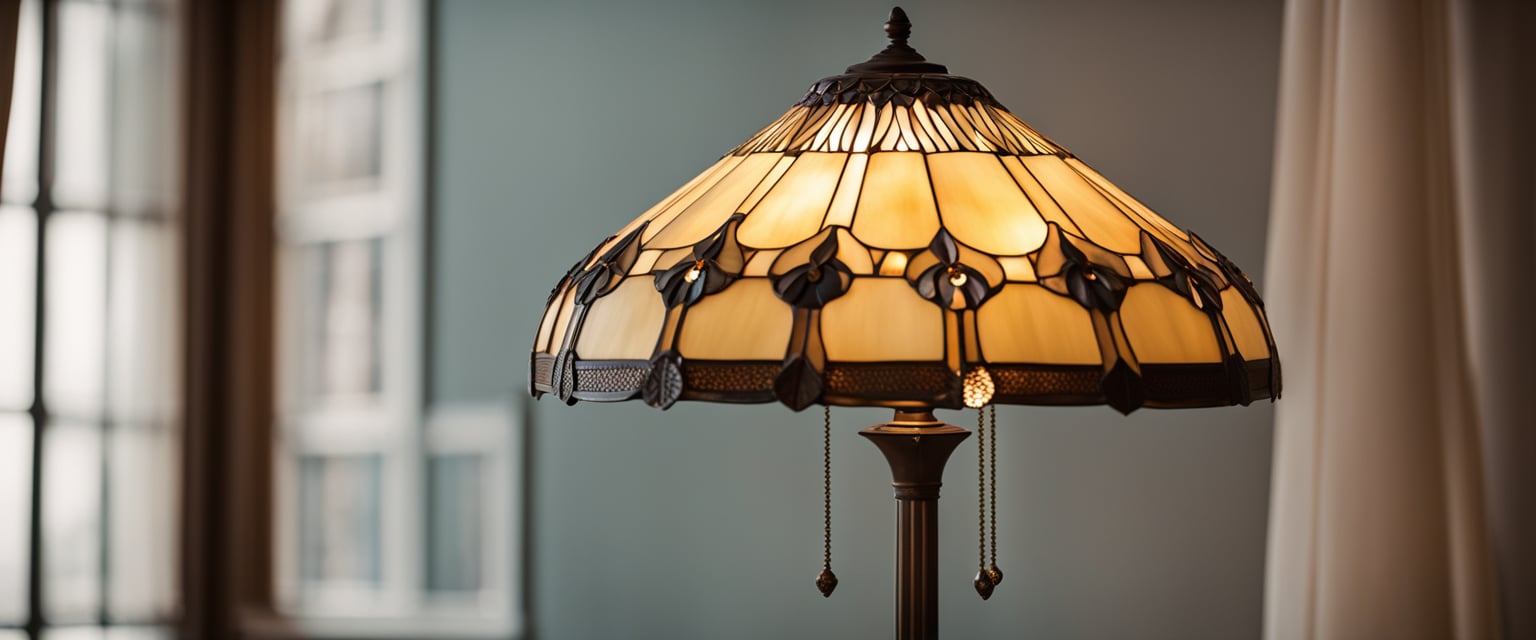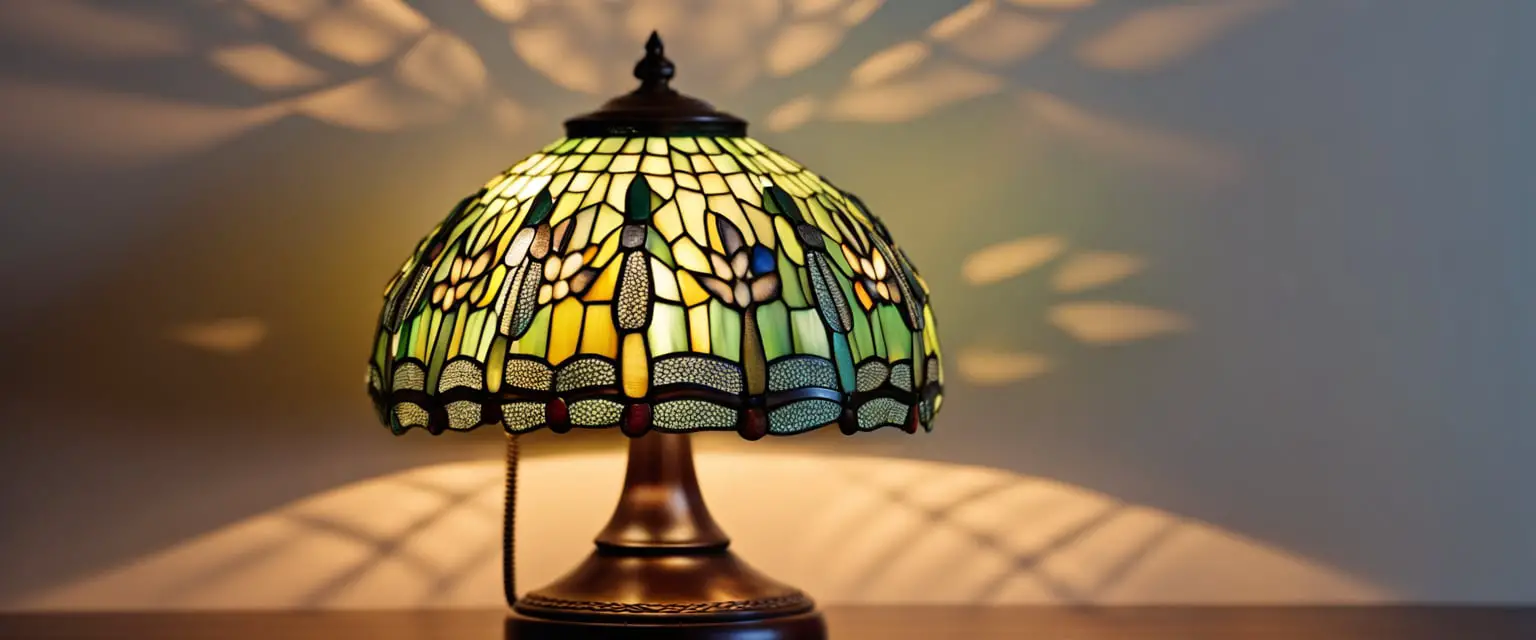Favrile glass, trademarked in 1894 by Louis Comfort Tiffany, is renowned for its iridescent and hand-wrought qualities, which evoke ancient handmade glassware. The term “Favrile Glass” is derived from the old English “fabrile,” meaning “hand-wrought,” underscoring the meticulous craftsmanship and unique iridescence that set this art glass apart (source: Invaluable).
This post aims to captivate and educate readers about the exquisite artistry and historical significance of Favrile glass, shedding light on its iridescent allure and the meticulous craftsmanship that distinguishes it as a timeless treasure in the world of art and glassmaking. Whether you’re an art enthusiast or simply curious about the beauty of Favrile glass, this post invites you to delve into its rich history and enduring charm.

Table of Contents
Affiliate Disclaimer
As an affiliate, we may earn a commission from qualifying purchases. We get commissions for purchases made through links on this website from Amazon and other third parties.
Origins of Favrile Glass
Favrile glass is an iridescent art glass that Louis Comfort Tiffany developed in the late 19th century. The word “Favrile” is derived from the Old English word “Frabrile,” which means “handmade.” Tiffany named the blown glass from his furnaces Favrile, a trademark that signified glass of hand-made and unique quality.
Louis Comfort Tiffany was an American artist and designer born in 1848. He was the son of the founder of the Tiffany Glass and Decorating Company, which produced stained glass windows in the late 19th and early 20th centuries.
Tiffany founded his first glassmaking firm in 1892, the Tiffany Glass and Decorating Company.
Tiffany patented the process for Favrile glass in 1894 and first produced the glass for manufacture in 1896 in Queens, New York.
Favrile glass is unique in that it contains metallic oxides fused into the glass during manufacturing. This process creates a unique iridescent effect that varies depending on the angle and intensity of light reflected off the glass.
Favrile glass was a significant innovation in art glass and helped establish Louis Comfort Tiffany as one of the most important glass artists of his time. Today, collectors highly seek out Favrile glass, which is considered one of the most significant contributions to glassmaking.
Louis Comfort Tiffany and Tiffany Studios
Biography of Louis C. Tiffany
Louis Comfort Tiffany was an American artist and designer best known for his work in stained glass. He was born in New York City on February 18, 1848, to Charles Lewis Tiffany, the founder of Tiffany & Co., and Harriet Olivia Avery Young.
He studied painting under George Inness and Samuel Colman and later attended the National Academy of Design in New York City.
Tiffany started experimenting with glassmaking in the 1870s, and in 1878, he founded the decorating firm, Louis C. Tiffany and Associated American Artists. He became interested in stained glass and began experimenting with it, eventually developing a new type of glass called Favrile. This glass differed from other stained glass because it was iridescent and had a unique texture.
Formation of Tiffany Studios
In 1892, Tiffany established Tiffany Studios in Corona, Queens, New York. The studio specializes in stained glass windows, lamps, mosaics, and other decorative objects. Tiffany’s Favrile glass is also produced at the studio.
Tiffany Studios became a leading producer of stained glass in the United States, and its work was highly sought after. The studio employed many artists and craftsmen, and its designs were known for their intricate details and vibrant colors.
In 1920, Tiffany’s glassmaking studios became Louis C. Tiffany Furnaces, Inc. This mark is found on a more modern piece than older Art Nouveau designs, which corresponds with the company’s transition to a more commercialized production.
Tiffany retired from Tiffany Studios in 1918 and created the Louis Comfort Tiffany Foundation, which has a $1 million endowment to aid and train young artists.
Artistic Characteristics of Favrile Glass
Louis Comfort Tiffany’s Favrile glass is renowned for its unique artistic characteristics. It is known for its iridescent qualities, ingrained in the glass itself, creating a lustrous surface reflecting light distinctively. The glass also features a variety of color and texture variations, making each piece unique.
Iridescent Qualities
Favrile glass is created by adding metallic oxides to the glass mixture. This creates a surface manipulation effect that produces iridescent hues. The iridescence is produced by the reflection and refraction of light on the glass’s surface. The glass can also produce a drapery effect, where the surface flows like fabric.
Color and Texture Variations
Favrile glass is known for its distinctive hues, ranging from deep blues and greens to warm oranges and yellows. The glass also features opalescent effects, where it appears to change color depending on the angle of the light. The glass’s texture can also vary, creating a range of surface finishes from smooth to rough.
Techniques and Craftsmanship
Tiffany’s Favrile glass was created using traditional glassblowing techniques and innovative new methods. The glass was blown and shaped by hand, allowing for unique variations in each piece. Various chemicals and heat treatments were also used to achieve the desired color and texture effects.
Favrile Glass Products
Louis Comfort Tiffany’s Favrile glass was used to create a variety of decorative items and architectural installations around the turn of the 20th century. The glass is known for its lustrous and iridescent appearance, which is ingrained in the glass itself. The following are some of the products that have been made using Favrile glass.
Vases and Decorative Objects
Favrile glass vases and decorative objects are highly sought-after antiques today. The glass was used to create various shapes and sizes of vases, bowls, and other decorative objects. The vases and bowls were often decorated with intricate patterns and designs, making them stand out as unique art pieces.
Lamps and Lighting
Favrile glass was also used to create decorative lamps and lighting fixtures. The glass was used to create shades for tables, floors, and hanging lamps. The lamps were often decorated with intricate designs and patterns that illuminated when turned on. Today, collectors highly prize favrile glass lamps and lighting fixtures.
Jewelry and Accessories
Favrile glass was also used to create jewelry and accessories. The glass was often used to create pendants, brooches, and other jewelry pieces. The glass was also used to create small decorative objects such as perfume bottles, paperweights, and inkwells.
In addition to vases, lamps, and jewelry, Favrile glass was also used to create stained-glass pieces, pottery, and enamels. Tiffany Favrile glass is one of the most famous types of iridescent glass, and it inspired other glass companies like Loetz and Quezal to make their own beautiful iridescent glass with a similar look.
Tiffany Glass in Architecture
Louis Comfort Tiffany’s Favrile glass was used for decorative objects and architectural installations. The glass was incorporated into various structures, including stained glass windows, mosaics, and interior design to create a unique aesthetic.
Stained Glass Windows
Tiffany’s stained glass windows are some of the world’s most recognizable works of art. They are leaded glass and feature intricate designs incorporating Favrile glass.
Tiffany’s most famous stained glass window is the “Dream Garden,” which Maxfield Parrish commissioned for the lobby of the Curtis Publishing Company in Philadelphia. The window features a dreamlike landscape with vibrant colors and intricate details.
Mosaics and Interior Design
Tiffany’s Favrile glass was also used in mosaics and interior design. One of the most famous examples of Tiffany’s work in interior design is the Palacio de Bellas Artes in Mexico City.
Tiffany designed the interior of the building, which features a stunning mosaic ceiling made of Favrile glass. The mosaic depicts a starry sky with a central sunburst.
Innovation and Influence
Louis Comfort Tiffany’s Favrile glass was a revolutionary innovation that changed the course of glass art history.
The Favrile glassblowing process was complex. The glassblower combined different kinds of glass, manipulating the colors and forms of the glass. Ultimately, the glassblower coated the work in metallic oxides to give it an iridescent or color-changing quality.
The Favrile glass differed from most iridescent glasses because the color and distinctive coloring were ingrained in the glass.
Art Nouveau Movement
Tiffany’s Favrile glass was a perfect fit for the gaining popularity of the Art Nouveau style at the time. The iridescence of Favrile glass perfectly complemented the naturalistic forms and flowing lines of Art Nouveau.
Tiffany’s work was soon recognized as the epitome of Art Nouveau glass, and his designs influenced many other glass artists.
Contemporary Glass Art
Tiffany’s Favrile Glass continues to influence contemporary glass art. The Favrile glassblowing process is still used today, and many artists continue to experiment with the technique to create new and innovative works.
The iridescence of Favrile glass is still a popular feature in contemporary art, and many glass artists continue to be inspired by Tiffany’s work.
Collections and Exhibitions
Louis Comfort Tiffany’s Favrile glass has been showcased in many museums and private collections worldwide. This section will highlight some of the most notable public displays and private collections.
Museums and Public Displays
The Victoria and Albert Museum in London, England, has an extensive collection of Favrile glass, including vases, lamps, and other decorative objects.
In 1899, Tiffany won the grand prize for his Favrile glass at the Paris Exposition Universelle and many of these pieces are now on display at the museum.
The Art Institute of Chicago is another museum with an impressive Tiffany’s Favrile glass collection. The museum’s collection includes over 1,500 pieces of Tiffany glass, including vases, lamps, and windows.
The collection was donated to the museum by H. O. Havemeyer, one of the first collectors of Favrile glass.
Private Collections
Many private collectors have also acquired Favrile glass over the years.
One notable private collection of Favrile glass is the collection of Stanley and Dolores Sirott. The Sirott’s collection includes thirty-two exquisite glass vases designed by Louis Comfort Tiffany.
These vases were showcased in an exhibition at The Huntington in the fall of 2024.
Tiffany Glass Techniques
Louis Comfort Tiffany was a master of glassmaking, and his techniques revolutionized the art. His unique glassmaking process, etching and surface work, and mold casting made his glass so distinct.
Glassmaking Process
Tiffany’s glassmaking process involved using the copper-foil technique, which allowed for greater control over the shape of the glass pieces.
The process involved cutting out a pattern from a piece of paper and then tracing it onto the glass. The glass was cut into the desired shape, and copper foil was wrapped around the edges. The pieces were then soldered together to create the final product.
Etching and Surface Work
Etching and surface work were crucial to Tiffany’s glassmaking process.
Tiffany would etch designs into the glass using hydrofluoric acid, creating a textured surface that would catch the light and create a shimmering effect. He would also use a variety of surface treatments, such as enameling and painting, to create intricate designs and color patterns.
Mold Casting
Tiffany also used mold casting to create his glass pieces.
This process involved pouring molten glass into a mold and shaping it as it cooled. Mold casting allowed Tiffany to create complex shapes and designs that would have been difficult to achieve using other techniques.
Tiffany’s glassmaking factory was located in Queens, New York, and employed over 300 workers. The factory produced various glass products, from lamps and windows to vases and bowls. Tiffany’s glass was highly sought, and his techniques continue influencing glassmakers today.
Significant Collaborations and Contributions
Louis Comfort Tiffany was a master of collaboration. He collaborated with a range of artists and designers to create his stunning glass pieces. Here are some of the most significant collaborations and contributions that helped shape the Favrile glass legacy.
Associated Artists and Designers
Tiffany worked with various artists and designers, including Maxfield Parrish, George Inness, and Samuel Colman. These collaborations were crucial to the development of Favrile Glass, as they brought new ideas and perspectives to the table.
Maxfield Parrish was a prominent illustrator and painter who worked with Tiffany on several projects. He was particularly influential in developing Tiffany’s stained glass windows, which are known for their rich colors and intricate designs.
George Inness was a landscape painter who worked with Tiffany on several interior design projects. His use of light and color inspired Tiffany to experiment with new techniques and materials.
Samuel Colman was a painter and interior designer who worked with Tiffany on several projects. He was particularly influential in developing Tiffany’s glass mosaics, known for their intricate patterns and vibrant colors.
Tiffany Girls
One of Tiffany’s most significant contributions to the art world was his use of female designers, known as the “Tiffany Girls.”
These women created some of Tiffany’s iconic designs, including the famous Dragonfly lamp.
Clara Driscoll was one of the most prominent Tiffany Girls and was crucial in developing Favrile glass.
She was responsible for creating many of the designs used in Tiffany’s glass pieces, and her work helped shape the aesthetic of the Art Nouveau movement.
Authentication and Marks
Authenticating Favrile glass can be challenging, but there are particular marks one can look for to determine its authenticity.
The marks vary from piece to piece and across different decades, making counterfeiting easier. However, there are several ways to authenticate the glass.
One of the most common marks to look for is the “L.C.T. Favrile” mark. This mark stands for Louis Comfort Tiffany, who developed the Favrile glass in 1894. The mark can be found etched into the bottom of the piece or on a paper label.
The “L.C.T.” mark alone is not enough to authenticate the piece, as it was also used on non-Favrile glass.
Another mark to look for is the “L.C. Tiffany” mark. This mark is used on non-Favrile glass pieces and does not guarantee authenticity. However, if the mark is accompanied by the word “Favrile,” it can indicate that the piece is authentic.
The “Cobweb and Apple Blossom” mark is another sign of authenticity.
This mark guarantees authenticity and is found on some Favrile glass pieces. It consists of a cobweb-like pattern with an apple blossom in the center. The mark was used from 1900 to 1902 and is a rare find.
In addition to these marks, there are other signs to look for to authenticate Favrile glass.
These signs include the glass’s color, the iridescence’s quality, and the piece’s overall design. If all of these factors align, the piece is likely authentic.
Preservation and Restoration
Favrile glass is a delicate material that requires careful handling and preservation to maintain its beauty and historical significance. The Louis Comfort Tiffany Foundation, dedicated to preserving the legacy of the famous glass artist, has developed specific guidelines for handling and restoring Favrile glass objects.
Proper cleaning and maintenance is one of the most critical aspects of Favrile glass preservation.
The stained-glass screen must be handled carefully to avoid damaging its delicate surface. The brass frames that hold the glass panels in place should be cleaned with a soft cloth and mild detergent to prevent damage to the metal.
When restoring Favrile glass, using materials and techniques compatible with the original glass is essential.
The restoration process should be undertaken by a skilled conservator who has experience working with Favrile glass and understands the material’s unique properties.
In some cases, Favrile glass may require more extensive restoration work, such as replacing damaged or missing glass panels.
In these situations, it is essential to use glass that closely matches the original in terms of color, texture, and composition.
Frequently Asked Questions
How can you identify authentic Tiffany Favrile glass marks?
Authentic Tiffany Favrile glass marks are typically engraved, acid-etched, or stamped on the bottom of the piece. The mark usually includes the word “L.C. Tiffany,” “L.C.T,” or “Tiffany Studios,” along with the model number or pattern name.
It is important to note that not all authentic Favrile glass pieces are marked, so other factors, such as the quality of the glass and the design, should also be considered.
What are the distinguishing characteristics of a Favrile glass vase?
Favrile glass vases are known for their iridescent quality, achieved by embedding color within the glass. This creates a unique and shimmering effect that changes depending on the angle of the light.
Favrile glass is also characterized by its organic shapes and intricate designs, often featuring natural motifs such as flowers or leaves.
What is the estimated value of authentic Favrile glass pieces?
The value of authentic Favrile glass pieces can vary widely depending on factors such as the rarity of the piece, the condition, and the demand among collectors.
Some pieces, such as large vases or lamps, can fetch prices in the tens or hundreds of thousands of dollars at auction. However, more familiar pieces, such as small bowls or plates, maybe more affordable.
How does Favrile glass differ from other Tiffany stained glass?
While Tiffany is perhaps best known for his stained glass windows, Favrile’s glass is different.
Unlike stained glass, which is made by assembling cut pieces of colored glass, Favrile glass is created by embedding color within the glass itself. This allows for a broader range of colors and effects and a more three-dimensional quality.
What techniques were used in the creation of Favrile glass?
Favrile glass was created using various techniques, including blowing, shaping, and cutting the glass.
One of the most important techniques used in creating Favrile glass was applying metallic oxides to its surface. These oxides would react with the glass during the firing process, creating the iridescent effect characteristic of Favrile glass.
During which period was Favrile glass primarily produced?
Tiffany Studios primarily produced favrile glass between 1894 and 1920. During this period, Louis Comfort Tiffany and his team of skilled artisans created a wide range of pieces, including vases, lamps, bowls, and plates. While the production of Favrile glass declined after Tiffany’s death in 1933, it remains highly sought after by collectors today.




Leave a Reply